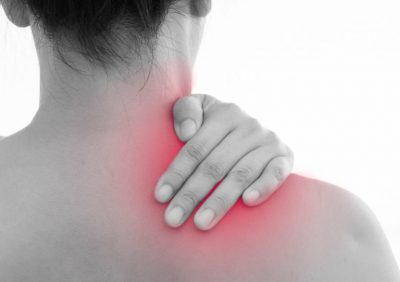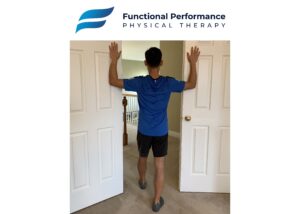
I’ve never met such a caring, understanding, and knowledgable medical professional. Now I know that a relatively pain-free life is possible for me. Thank you, Dr. Seo, for giving me back my future and my quality of life!
Jamie M
Stretching and Massage Does NOT Get Rid of Upper Trap Pain

Most of us carry a lot of tension in the upper trapezius and neck muscles. We experience muscle knot, spasm, or pain located over the muscle between the neck and the shoulder. Typically, most online searches will direct you to self-treat by doing shoulder shrugs, stretch, massage or rolling with a lacrosse ball. And if the pain gets worse, medical professionals prescribe oral medication, topical patches, or perform injections with numbing medications or even Botox. However, all of these treatments are minimally effective for a short period of time because they are not addressing the root of the problem. Instead, you are just treating the pain. Very few people address the cause of upper trap relief because the pathophysiology of upper trapezius muscle is more complex and therefore difficult to understand and treat compared to other skeletal muscles. Injections and oral medications that cover up the pain temporarily are commonly performed because the results are immediate for a short period of time and we live in a culture that seeks immediate gratification. Smart and health conscious healthcare consumers quickly realize that repetitive treatment to fool the brain is not the best way to take care of our body.
Myofascial Pain
To better understand upper trapezius muscle “knot” spasm, we need to understand why these spasms develop in the first place. The medical term for this type of pain is called myofascial pain. Muscle pain occurs when the muscle fascia, which is the casing covering the muscle fibers become inflamed by several mechanisms including repetitive low-level muscle contractions, strain, direct trauma, muscle overload, lack of use, or shortening of muscles. Other factors such as scoliosis, leg length discrepancies, vitamin deficiencies, stress and anxiety increase the chronicity of myofascial pain.
The main role of a muscle is to pull by contracting muscle fibers from one attachment to another via the attachment points. Usually, between the two points of attachment, there is a joint along with sensors that detect the tone and length of the muscles. When the muscle is not in use, it’s in a relaxed state. However, when abnormal stimulus is introduced to the muscles, it reflexively contracts and the distance between the two points shorten. As a result, muscle tone and the nervous system sends pain signals to cause inflammation. In addition, when the muscles are in a contracted state, they become weaker.
When muscles are inflamed, they often form trigger points, which feel like knots. Trigger points are painful when pressure is applied. And it also refers pain to another area of the body. In the case of the upper trapezius muscles, the referred pain can be located on the side and top of the neck, base of the skull, lower jaw and side of the head triggering headache pain.

David G. Simons, Janet Travell, Lois S. Simons, Travell & Simmons’ Myofascial Pain and Dysfunction, The Trigger Point Manual, Volume 1. Upper Half of Body: Second Edition,© 1999 Williams and Wilkens
Complexity of the Upper Trapezius Muscle
The upper trapezius is a complex muscle in that the muscle crosses over a dozen joints. Therefore, any shift in the spine such as poor posture or muscle imbalance can significantly affect the muscle. And as mentioned above, shortening of any one of the joints will involuntarily contract the upper trapezius and produce knots and pain.
Equally important, the upper trapezius is innervated by the spinal accessory nerve, which is also very intricate. In most cases, nerves travel from the spinal cord directly to the muscles. However, as the name implies, the spinal accessory nerve is unique in that it is composed of two parts: from the spinal cord and from the brain. This is the only nerve in our body that enters and then exits the skull which then innervates to the upper trapezius muscle and the sternocleidomastoid.

How Poor Posture Affects the Upper Trapezius Muscle

The average person that works in an office sits up to 12 hours a day. In addition, we sit in our car and in front of the TV, and while looking at all of our electronic devices. All of these activities cause us to slouch, which brings the shoulders forward and causes the upper back to hunch. This will result in the head to come forward. But in order for us to see forward, we lift the head up, which causes compression on the back of the upper neck where the skull meets. This mechanical encroachment causes pressure on the pathway where the spinal accessory nerve enters and exits the skull. When the nerve is irritated, it sends signals to the muscle and causes contraction, in this case, it’s the upper trapezius and another muscle in the front of the neck called sternocleidomastoid. Over a period of time these micro-contractions lead to trigger points and cause pain. To make matters worse our body curls forward when we are in pain. This vicious cycle continues and causes more muscle spasms, pain, and poor posture.
This is the main reason why traditional treatments only work briefly. It is imperative to address the root of the problem – the shortened soft tissues between the upper neck and skull that’s causing compression that innervates the upper trapezius.
Correct Movement is the Best Medicine of All
The most effective and fastest way to decompress this area is to seek care by an upper cervical spine specialist. In addition, you can perform exercises and make postural changes to reduce upper trap pain effectively. These self-treatments break the vicious cycle of pain and forward head posture which in turn puts less stress on the nerve that innervates the upper trapezius.
Good Posture is Key
Having sand as a foundation of a house is the same analogy as having poor low back posture for your neck and head. Notice that when you sit up straight and arch your back, your head comes up directly under your shoulders. Making changes in your posture will significantly decrease stress and tension in your upper trapezius.
• Placing a lumbar cushion or roll similar to this will encourage the spine to be upright. Use it whenever you sit in your desk or drive for a long period of time.
• Bring the monitor up high so you are not looking down the whole time. If you have a laptop, use a docking station and use a wireless keyboard and mouse so you avoid any forward head posture.
• Avoid looking at your phone in bed. Besides the mechanical stress on your body, screen time before bed leads to decreased quality of sleep and may lead to insomnia.

Simple Exercises to Perform
These 3 exercises will help to encourage your body to be in more of an upright posture. It’s important to do these daily to combat the forward head posture position we undoubtedly get into on a daily basis.
Half Kneeling Position

The half kneeling position places the pelvis and lumbar spine into an optimal position which directly influences the neck and head to be in a proper position, relieving abnormal mechanical stress on nerves that innervate the upper trapezius. To perform, get into a half kneeling position, as shown in the picture. On the kneeling leg, you should not be putting any weight on the knee cap, instead you should be feeling slight pressure on the bone under the knee cap. Make sure your knees are bent at 90 degrees. Rotate your pelvis back (posterior rotation). You may hold onto a stable surface to maintain good balance in the beginning. Hold this position for 30 seconds and repeat 3 times on both legs. This stretch can be progressed by raising your arm up on the side where the knee is on the ground.
Pec Stretch


This stretch will help to stretch the muscles that are causing your shoulders to round forward. Stand in a doorway. Bend your elbows to 90 degrees and place your forearms and hands on the door frame. Keeping your back and head straight, step one foot forward and lean your chest forward through the door. You should feel a stretch across your chest. Hold for 30 seconds and repeat 3 times. You may repeat the set by dropping your elbows closer to the body as shown in the picture above.
Prone Scaption
This exercise will help to increase strength of your lower trapezius to offset the hyperactivity of the upper trapezius muscle. Lie on your stomach with one arm hanging straight down on the end of the table or bed with palms facing in. Or you can even go on your hands and knees to engage more of your core muscles. Raise your arm up at a 30 degree angle with your thumb pointing up toward the ceiling. Do not go above shoulder level and avoid swinging your arms. Do 2-3 sets of 10-15 reps. When the movement gets easier, use a very light dumbbell to increase the intensity.
Summary
Stretching and massage may not alleviate the knots in your upper trap. Try everything above and if you still suffer from neck and upper trap pain, fill out the form below and get out of pain immediately. We serve patients from Bryn Mawr, Radnor, Havertown, Ardmore, Wynnewood, Philadelphia, and surrounding areas.

